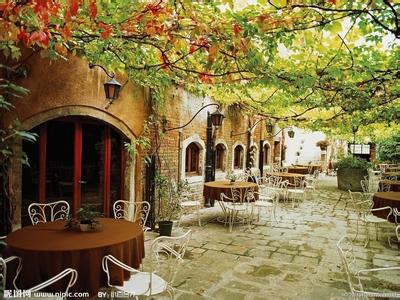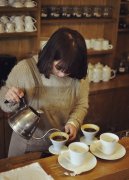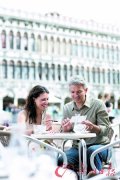What is the ideal of a cafe?

The Arab said: wherever we entertain guests with coffee, we will make the noblest and most tolerant friends.
The Turks say that the cafe is a symbiosis of Islamic tradition and secular culture.
The British said: the cafe used to be a trading market and information center, as well as a democratic conference room for liberal factions.
The French say: cafes give birth to the most romantic era of literature and art in the world.
The Austrian said: I'm not in the cafe. I'm on my way to the cafe.
The Italian said: the cafe is the second home, lively and warm.
Americans say: cafes are a symbol of fashion culture.
Cafes once had a period of prosperity in Shanghai. It was in the 1920s and 1930s that luxury Parisian-style cafes spread all over the streets of the French concession. Although cafe culture was very popular at that time, drinking coffee was only the pleasure of life for the upper class and the intellectual class. The left-wing culture in the period of the Republic of China originated from the public coffee cafe in Hongkou District. According to literature records, the scene of intellectuals debating and talking in the coffee shop at that time was very close to the model of the European Literature Cafe. At that time, all kinds of amorous feelings of cafes often appeared in film and television works, and the perfect combination of European fashion and old Shanghai customs could not help saying that it was a wonderful work in the cultural history of cafes.
After a hundred years of development in Shanghai, the cafe business is now showing a scene of prosperity. According to incomplete statistics, there are more than 700 cafes in Shanghai. Coffee shop chains of major brands have sprung up in Shanghai: Starbucks and TheCoffeeBean&TeaLeaf in the United States, COSTACOFFEE and Citta in Italy, GloriaJean'sCoffees and JamaicaBlue in Australia, real pot in Japan and local coffee on the island. They are practical cafes, decorated in a concise and capable style, and the shop assistants wear unified leisure uniforms and operate all kinds of coffee machines fluently and quickly. Guests can spend the afternoon holding porcelain coffee cups in the shop, or they can wait for takeout coffee in paper cups at the bar. The former is French romance, the latter is American chic. Most of these coffee chains are opened in crowded shopping malls, pedestrian streets or the ground floor of high-end office buildings. their excellent geographical location and excellent quality guarantee make them the mainstay of the Shanghai coffee market.
In addition to these sizeable corporate coffee chains, Shanghai also has a large number of private cafes. Gardenbooks on Changle Road, Hanyuan Book House on Shaoxing Road, Shack Book Bar on Nanchang Road and Colorful on Changde Road are coffee shops in the form of book bars; small gardens on Kangping Road, ViennaCafe on Shaoxing Road, Rose Cafe on Maoming South Road, Xiaduo Garden on Fuxing West Road, AURA on Jiaozhou Road, etc., create a leisurely and elegant drinking space with the unique charm of garden house architecture. The secret garden on Fahua Town Road and the antique garden on Sinan Road are dominated by retro and European-style furniture and decoration, and most of the furnishings in the store can be sold. Laomai Cafe on Taojiang Road has become a paradise for photography lovers in Shanghai with its successful ShabbyChic style, and the store even put up a sign charging 50 yuan for commercial photography. The old movie cafe on Duolun Road takes the old Shanghai style to the extreme, attracting a large number of tourists and nostalgic elements. These cafes are excellent works of art in the culture of Shanghai cafes. They are more like exquisite works of art, emitting strange fragrance due to the strong emotion and unique taste of the owner. In addition, there are many timely themed cafes in Shanghai, such as movie cafes, DIY baking cafes, comic book cafes, board game cafes, maid cafes, pet cafes and so on.
The cafes in Shanghai are also inextricably linked with the literary and art circles, and there are cafes in all the major art landmarks. For example, Moke Restaurant on the top floor of Shanghai Museum of Contemporary Art, Kathleen's5RooftopRestaurant&Bar on the top floor of Shanghai gallery, half-degree canopy in RAMCAFE,M50 on the top floor of gallery on the Bund, TRAVELEDCFFEE&TEA, CafeNuBbaumKonditorei, BecaCafe&Bar in Hongfang, etc. Most of the cafes in the contemporary gallery are minimalist, while the cafes in the major creative parks take a steady and warm decoration route. The close relationship between art and coffee culture is also reflected in the major cultural and ecological communities in Shanghai. Whether it is Xintiandi, Tianzi Square, Tongle Square or 1933 old factory buildings, Outer Road, Shangjie LOFT and No. 8 Bridge, as long as you walk through it, you can always find some charm of the left bank. The closeness between coffee and art is also reflected in some gallery coffee bars. Both Dingsheng gallery on Ruijin second Road and PlumUrbanGallery on Nanjing West Road have opened cafes into galleries. In recent years, the coffee bar leisure area opened up by the organizing committee can also be seen at some large art fairs in Shanghai. People trade artworks in the coffee shop, or talk freely about their feelings and exchange of needed goods.
Due to the strong impact of Internet culture, home culture, modern communications and media, as well as the popularization and slum of coffee drinks, cafes are no longer a necessary place for people's social life, and the sale of coffee is no longer the monopoly of cafes. The importance of cafes is becoming more and more blurred in modern society, which is not only the current situation of Shanghai cafes, but also the problem of European cafes. In my opinion, the unique secret recipe that distinguishes cafes from other places and develops to this day is the enduring ideals of cafes: equality, fraternity, freedom and rebellion. The cafes in Shanghai tend to be gentle, lonely, quiet and nostalgic at the beginning, mixed with admiration and unprincipled worship. Unlike the European cafe culture, the Shanghai Cafe is only a symbol of some nobility and elegance-an influence that may continue to this day.
Most of today's cafes are permeated with a relaxed and comfortable atmosphere, and the existence of cafes represents another force to compete with the fast-paced city life. Busy urbanites achieve an ideal state of relaxation while drinking coffee, and get a moment of relief from the tension of daily life in the coffee-scented Utopia. Some consumers' requirements for the environment of the cafe even exceed the coffee itself. This pure spiritual enjoyment and the innate progressive spirit of the cafe lead the aesthetic trend of the younger generation in Shanghai.
In any case, the cafe attracts visitors from all directions in Shanghai with its unique literary flavor and strong historical accumulation. Chinese, foreigners, people of different occupations and different identities all gather in the city center or a couple in a quiet alley. Through the window, they are either talking about something, or sitting alone in a corner reading books and newspapers. However, no matter coffee, tea or garlic, people should not lose the ideal of a cafe. This is not only the ideal of cafes, but also the direction in which all human beings can develop healthily.
Important Notice :
前街咖啡 FrontStreet Coffee has moved to new addredd:
FrontStreet Coffee Address: 315,Donghua East Road,GuangZhou
Tel:020 38364473
- Prev

The Development Prospect of Chinese Coffee Culture
According to the newly published sixth batch of sought-after occupations list, baristas are among the most sought-after occupations and are rated by many experts as fashion occupations with low entry barriers and good blueprints. According to reports from CCTV-2, China Talent Network and Sohu, there is a shortfall of 30, 000 baristas a year across the country. Chengdu now has about 700 coffee shops, large and small, and needs at least 3000 coffee workers a year.
- Next

Go into the world-famous cafes to taste the city culture
Sitting in a cafe sipping a drink is the best key to a city's culture. Coffee is a necessity in the life of Westerners. In terms of social function, the coffee shop is a bit like a Chinese teahouse: its emergence creates a public space and flattens the class distinction, and as prices fall, people from all walks of life can go for a drink and take part in gossip. After a few days
Related
- Detailed explanation of Jadeite planting Land in Panamanian Jadeite Manor introduction to the grading system of Jadeite competitive bidding, Red bid, Green bid and Rose Summer
- Story of Coffee planting in Brenka region of Costa Rica Stonehenge Manor anaerobic heavy honey treatment of flavor mouth
- What's on the barrel of Blue Mountain Coffee beans?
- Can American coffee also pull flowers? How to use hot American style to pull out a good-looking pattern?
- Can you make a cold extract with coffee beans? What is the right proportion for cold-extracted coffee formula?
- Indonesian PWN Gold Mandrine Coffee Origin Features Flavor How to Chong? Mandolin coffee is American.
- A brief introduction to the flavor characteristics of Brazilian yellow bourbon coffee beans
- What is the effect of different water quality on the flavor of cold-extracted coffee? What kind of water is best for brewing coffee?
- Why do you think of Rose Summer whenever you mention Panamanian coffee?
- Introduction to the characteristics of authentic blue mountain coffee bean producing areas? What is the CIB Coffee Authority in Jamaica?

